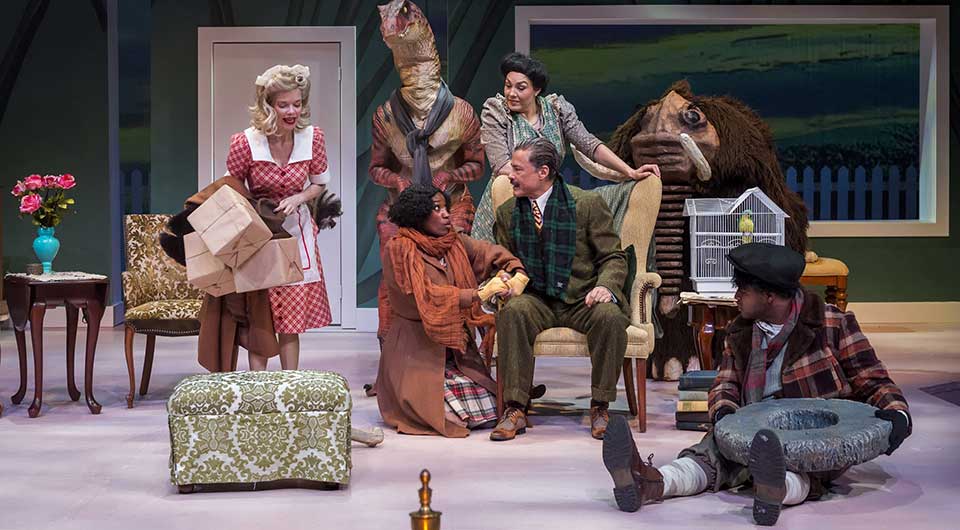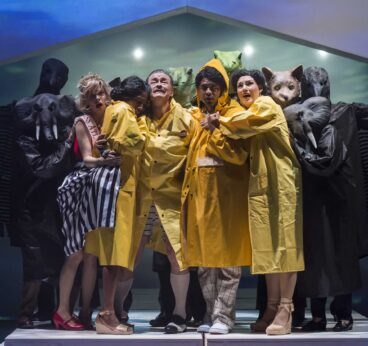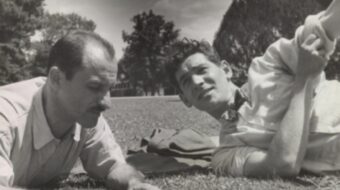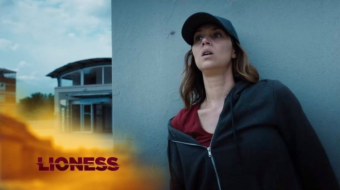
PASADENA, Calif.––American author Thornton Wilder (1897-1975) captured his third Pulitzer Prize in 1942 with his play The Skin of Our Teeth. The other two were for the novel The Bridge of San Luis Rey (1927) and his earlier play Our Town (1938).
The Skin of Our Teeth opened on Broadway on November 18, 1942, directed by Elia Kazan, starring Fredric March and Florence Eldridge as Mr. and Mrs. Antrobus, Tallulah Bankhead as their feisty maid Sabina and Montgomery Clift, at the beginning of his career, as the rambunctious son Henry. Employing novel theatrical techniques inspired by the post-World War 1 Dadaists, James Joyce, Gertrude Stein, and Alice B. Toklas (with whom he was friends, as he was also with Jean-Paul Sartre), the play was an immediate hit. Perhaps even surprising himself by the post-modern repercussions of his play, Thornton anticipated the existentialists (like Sartre) and absurdists (like Ionesco). Perhaps war has that effect as a way of coming to terms with the monstrosity of death and destruction.
Consider the moment. The U.S. had entered World War 2 less than a year before and was still rearming after a punishing Great Depression. The Nazis were advancing in Europe, bombing London and other targets in the UK, and the Japanese had conquered large swaths of Asia. Prospects for democracy were grim. Having overrun France, Denmark, Norway, and the Benelux countries and set up puppet regimes there, the Germans were now focusing their military might on bringing Soviet Russia to its knees. They had set siege to Leningrad and were at Moscow’s gates. From July 1942 until early February 1943, the Battle of Stalingrad (now called Volgograd) in southern Russia was the Soviets’ last stand, the most important battle of the Eastern Front, to prevent the Germans from accessing the oil fields of the Caucasus and the Middle East.
The course of World War II began turning when the Soviets, suffering grotesque losses, managed to inflict enough pain on the German forces to propel their slow retreat back across the steppes of Russia. The Soviets’ Western allies—perhaps more in name than in reality—are believed to have held back aid, waiting to witness the mutual destruction of both the Germans and the Soviets, prompting the Communist left in the Western nations to demand opening up the “second front” in Western Europe in a grand pincer action to keep the Germans occupied both east and west.
In that moment of suspended terror for what might yet come in this second World War, Wilder wrote his play to dampen the public’s fears of worldwide fascist victory and project a different ending of indomitability, of humanity surpassing any challenge ever encountered.
 Tellingly, the play launches the 2024-25 “True Grit” season at A Noise Within, with company co-artistic directors Julia Rodriguez-Elliott and Geoff Elliott co-directing. It’s truly a thrilling production of an important play.
Tellingly, the play launches the 2024-25 “True Grit” season at A Noise Within, with company co-artistic directors Julia Rodriguez-Elliott and Geoff Elliott co-directing. It’s truly a thrilling production of an important play.
Perhaps it’s relevant here to remind readers that Wilder served in the war until 1945 and rose to the rank of lieutenant colonel in the U.S. Army Air Force Intelligence (the Air Force became a new branch only in 1947), first in Africa, then Italy, receiving several military service awards. He was willing to put himself on the firing line and certainly knew that millions of others did as well.
The story of human existence that Wilder tells is that of the archetypal American family: Mr. and Mrs. Antrobus (Frederick Stuart and Trisha Miller), living in Excelsior, N.J., with daughter Gladys (Mildred Marie Langford), son Henry (Christian Henley), and sharp-witted screwball family maid Sabina (Ann Noble). This year, George and Maggie Antrobus are celebrating 5000 years of marriage (assuming that such an institution even existed that long ago, but it is brought out that Sabina is something more than a maid—centuries ago, George had kidnapped her as his second wife. George invented the wheel and the alphabet and is now the local Chamber of Commerce president.
Writing for the Broadway stage, Wilder tells a quintessentially American, middle-class story. Of course, many other civilizations tell quite different creation histories of the world and revere other saints and wisdom carriers besides Moses and Biblical Scripture, Homer, Aristotle, Spinoza, and the Muses. Through it all, even cohabitating with dinosaurs and woolly mammoths, they survive by “the skin of their teeth.”
Was it just “colorblind casting” that landed two African-American actors in the roles of the two children, Gladys and Henry? Perhaps the directors wanted to signal that the somewhat idealized bourgeois Antrobus family experience in New Jersey was not necessarily shared by so many other classes and races of people in America.
“It’s one of the most profound plays ever written about the human experience, and also one of the funniest,” says Geoff Elliott. “There are very few plays that are not only epic in scope but also epically funny. It’s an extremely inspiring and moving comedy about one particular family but also about the family of humanity. We go back to the great thinkers. We go back to what it means to come together universally, as a whole. So that we can rebuild again.”
“It’s a roadmap to survival,” adds Rodriguez-Elliott. “This is a play that resonates most deeply at moments when it feels like we’re on the brink of destruction and that things feel bleak. And that’s the moment we are currently living in. Yet it’s incredibly optimistic because it reminds us all that these are cycles we keep going through as human beings.”
Production-wise, one could not have wished for a finer staging. It’s brilliant in every respect, exploiting all the intended wackiness to the hilt, and certainly on a par with the 2019 Will Geer Theatricum Botanicum version I reviewed back in 2019. It is truly an American classic, and anyone who loves our national theatrical saga would be well advised to take it in. Details such as an offhand reference to the play Angels in America or the anachronous inclusion of “The Girl from Ipanema” in the Atlantic City beachfront scene bring a smile to the proceedings.
Yet this is where I see a disconnect between Wilder’s clear social commitment, his get-off-the-couch action during the war, and the somewhat passive point of view in some of his greatest inventions—in his three Pulitzer-winning works, for example. In The Bridge of San Luis Rey, we learn of the sudden collapse of a bridge in which several (fictional) characters in colonial-era Peru fall to their deaths, people from the proverbial “all walks of life,” rich, poor, educated, illiterate. Wilder examines how these individuals happened to be on the bridge at that moment, creating absorbing backstories for them. However, the basic point is their helplessness at the moment of crisis, the absence of agency they might have utilized.
Similarly, in his play Our Town, at the risk of oversimplifying one of the greatest and most beloved American dramas, what we have are several characters in an afterlife locale—Elysium, let’s say—who look down on the little New Hampshire town of Grover’s Corners where they lived, and feel despair that no one down there seems to appreciate life as much as they should. Yet where they are now, they are powerless to make any difference anymore, and the people on Earth, like those in Skin of Our Teeth, will just have to bear up somehow.

In like fashion, in The Skin of Our Teeth, the floods, the wars, the Ice Age, the heat waves, pestilence, plague, war, and depression all just “happened” to humanity, and we just muddle through, bumbling and fumbling like the flawed mortals we are—or immortals, we might say here. Perhaps Wilder was reacting to the 1930s proletarian esthetic, the theater of action, or maybe just the straitjacket of the “well-made play.” But in any case, his best-known work is characterized by this fatalistic sense that, in the end, human will counts for so little. That tenuous respect for human agency prompted some of the left-wing cultural critics of the post-war era to seriously interrogate existentialism, surrealism, the Beats, the absurdists, the fantasists, the abstract expressionists. Had they nothing to fight for? And could their sense of artistic removal be coopted into inaction?
Idle musings of a commie critic, perhaps. Take them for what they’re worth. But in the current age of climate crisis can humanity afford such disengagement?
The creative team for The Skin of Our Teeth includes scenic designer Frederica Nascimento, lighting designer Ken Booth, composer and sound designer Robert Oriol, costume designer Garry Lennon, wig and makeup designer Tony Valdés, and dramaturg Miranda Johnson-Haddad. Angela Sonner, assisted by Hope Matthews, is the production stage manager.
The cast includes Kasey Mahaffy, Cassandra Marie Murphy, Anthony Adu, Stella Bullock, Julia Chavez, Jacob Cherry, Yannick Haynes, Amber Liekhus, Veronica McFarlane, David A. Rangel, Landon M. Robinson, Micah Schneider, and Maya Sta. Ana.
The Skin of Our Teeth runs through September 29 on Thurs., Fri., and Sat. at 7:30 p.m., and Sat. and Sun. at 2 p.m. Post-performance conversations with the artists will take place every Friday. A Noise Within is located at 3352 E. Foothill Blvd., Pasadena 91107. For more information and to purchase tickets, call (626) 356–3100 or go to the company website. www.anoisewithin.org.










